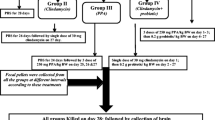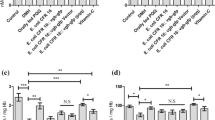Abstract
The present study investigated the therapeutic effects of probiotics on brain intoxication induced by clindamycin and propionic acid (PPA) in hamsters. Fifty golden Syrian hamsters were randomly divided into five experimental groups of ten animals each: (A) control group receiving phosphate buffered saline; (B) oral buffered PPA-treated group being administered with a neurotoxic dose of 250 mg/kg PPA during three days; (C) oral clindamycin-treated group receiving a single dose of 30 mg clindamycin/kg; and (D, E) the two therapeutic groups being administered the same doses of clindamycin and PPA followed by probiotics for three weeks at a daily dose of 0.2 g/kg. Biochemical parameters of energy metabolism and oxidative stress were examined in brain homogenates from all hamsters. The development of pathogenic bacteria was monitored on stool samples from all hamsters. Descriptive changes in fecal microbiota and overgrowth of Clostridium species in clindamycin and PPA treated hamsters were recorded. Interestingly, probiotics were shown effective to restore normal gut microbiota. Clindamycin and PPA treatments caused an elevation in lipid peroxidation and catalase activity, as oxidative stress markers, together with a reduction in GST activity and GSH level. Energy metabolism impairment was ascertained via the activation of creatine kinase and a decrease of lactate dehydrogenase. These findings suggest that bacteria overgrowth caused by PPA and clindamycin was efficient to illustrate signs of neuronal toxicity. The present study indicates that probiotic treatment can improve poor detoxification, oxidative stress, and altered gut microbiota as mechanisms implicated in the etiology of many neurological disorders.


Similar content being viewed by others
Change history
31 August 2018
The original version of this article unfortunately contained a mistake. The family name of the fourth author listed in the title was incorrect, and the correct name is Nadine Moubayed, as noted in the addresses. Her name is now corrected in the author group of this article.
Abbreviations
- AUC :
-
area under the curve
- BAP :
-
Sheep Blood Agar plate
- BBB :
-
blood-brain barrier
- CDNB :
-
1-chloro-2,4-dinitrobenzene
- CFU :
-
Colony-forming unit
- CK :
-
creatine kinase
- CNS :
-
center nerves system
- ENS :
-
enteric nervous system
- ETC :
-
electron transport chain
- GI :
-
gastrointestinal tract
- GSH :
-
glutathione
- GST :
-
glutathione-s-transferase
- H 2 O 2 :
-
hydrogen peroxide
- HK :
-
hexokinase
- LDH :
-
lactate dehydrogenase
- MCA :
-
MacConkey Agar
- MD :
-
malondialdehyde
- PPA :
-
propionic acid
- ROC :
-
Receiver Operating Characteristics
- ROS :
-
reactive oxygen species
- SCFA :
-
Short-Chain Fatty Acids
- SDA :
-
Sabouroud Dextrose agar
References
Al-Dbass AM (2014) N-Acetylcysteine reduces the neurotoxic effects of propionic acid in rat pups. J King Saud Univ Sci 26:254–260
Al-Gadani Y, El-Ansary A, Attas O, Al-Ayadhi L (2009) Metabolic biomarkers related to oxidative stress and antioxidant status in Saudi autistic children. Clin Biochem 42:1032–1040
Amador E, Dorfman LE, Wacker WE (1963) Serum lactic dehydrogenase activity: an analytical assessment of current assays. Clin Chem 12:391–399
Amdekar S, Singh V (2016) Lactobacillus acidophilus maintained oxidative stress from reproductive organs in collagen-induced arthritic rats. J Hum Reprod Sci 9:41–46
Beutler E, Duron O, Kelly BM (1963) Improved method for the determination of blood glutathione. J Lab Clin Med 61:882–888
Bojes HK, Suresh PK, Millis EM, Spitz DR, Sim JE, Kehrer JP (1998) Bcl-2 and Bcl-xL in peroxide-resistant A549 and U87MG cells. Toxicol Sci 42:109–116
Borre YE, Moloney RD, Clarke G, Dinan TG, Cryan JF (2014) The impact of microbiota on brain and behavior: mechanisms & therapeutic potential. Adv Exp Med Biol 817:373–403
Brass EP, Beyerinck RA (1987) Interactions of propionate and carnitine metabolism in isolated rat hepatocytes. Metabolism 36:781–787
Brass EP, Beyerinck RA (1988) Effects of propionate and carnitine on the hepatic oxidation of short- and medium-chain-length fatty acids. Biochem J 250:819–825
Bronstein JM, Farber DB, Wasterlain CG (1992) Regulation of type-II calmodulin kinase: functional implications. Brain Res Brain Res Rev 18:135–147
Buffie CG, Jarchum I, Equinda M, Lipuma L, Gobourne A, Viale A, Ubeda C, Xavier J, Pamer EG (2012) Profound alterations of intestinal microbiota following a single dose of clindamycin results in sustained susceptibility to Clostridium difficile-induced colitis. Infect Immun 80:62–73
Chauhan V, Chauhan A (2006) Oxidative stress in Alzheimer's disease. Pathophysiology 13:195–208
Chauhan A, Gu F, Essa MM, Wegiel J, Kaur K, Brown WT, Chauhan V (2011) Brain region-specific deficit in mitochondrial electron transport chain complexes in children with autism. J Neurochem 117:209–220
Chegwidden WR, Watts DC (1984) Anion activation of monkey muscle creatine kinase. Int J BioChemiPhysics 16:1171–1174
Collins SM, Surette M, Bercik P (2012) The interplay between the intestinal microbiota and the brain. Nat Rev Microbiol 10:735–742
Cryan JF, Dinan TG (2012) Mind-altering microorganisms: the impact of the gut microbiota on brain and behaviour. Nat Rev Neurosci 13:701–712
El-Ansary AK, Ben Bacha A, Kotb M (2012) Etiology of autistic features: the persisting neurotoxic effects of propionic acid. J Neuroinflammation 9:74. https://doi.org/10.1186/1742-2094-9-74
El-Ansary AK, Al-Daihan S, Ben Bacha A, Shaker GH, Al-Ayadhi LY (2013) Comparative study on the protective effect of carnosine and carnitine against pro-inflammatory/pro-oxidant effects of clindamycin and propionic acid administrations to hamsters. Afr J Microbiol Res 7:103–114. https://doi.org/10.5897/AJMR12.1178
El-Ansary A, Bhat RS, Al-Daihan S, Al Dbass AM (2015) The neurotoxic effects of ampicillin-associated gut bacterial imbalances compared to those of orally administered propionic acid in the etiology of persistent autistic features in rat pups: effects of various dietary regimens. Gut Pathog 7:7. https://doi.org/10.1186/s13099-015-0054-4
El-Ansary A, Al-Salem HS, Asma A, Al-Dbass A (2017) Glutamate excitotoxicity induced by orally administered propionic acid, a short chain fatty acid can be ameliorated by bee pollen. Lipids Health Dis 16:96. https://doi.org/10.1186/s12944-017-0485-7
El-Ansary A, Bacha AB, Bjørklund G, Al-Orf N, Bhat RS, Moubayed N, Abed K (2018) Probiotic treatment reduces the autistic-like excitation/inhibition imbalance in juvenile hamsters induced by orally administered propionic acid and clindamycin. Metab Brain Dis 33(4):1155–1164
Farmer AD, Randall HA, Aziz Q (2014) It's a gut feeling: how the gut microbiota affects the state of mind. J Physiol 592:2981–2988
Finegold SM (2011) Desulfovibrio species are potentially important in regressive autism. Med Hypotheses 77:270–274
Foster JA (2013) Gut feelings: bacteria and the brain. Cerebrum 2013:9
Frei B (1994) Reactive oxygen species and antioxidant vitamins: mechanisms of action. Am J Med 97:5S–13S discussion 22S-28S
Fung TC, Olson CA, Hsiao EY (2017) Interactions between the microbiota, immune and nervous systems in health and disease. Nat Neurosci 20:145–155
Gibson GR, Probert HM, Loo JV, Rastall RA, Roberfroid MB (2004) Dietary modulation of the human colonic microbiota: updating the concept of prebiotics. Nutr Res Rev 17:259–275
Holdeman LV, Cato EP, Moore WEC (1977) Anaerobe laboratory manual. Anaerobe Laboratory, Virginia Polytechnic Institute and State University, Blacksburg
Hunt CR, Sim JE, Sullivan SJ, Featherstone T, Golden W, Von Kapp-Herr C, Hock RA, Gomez RA, Parsian AJ, Spitz DR (1998) Genomic instability and catalase gene amplification induced by chronic exposure to oxidative stress. Cancer Res 58:3986–3992
Itoh K, Mitsuoka T, Sudo K, Suzuki K (1983) Comparison of fecal flora of mice based upon different strains and different housing conditions. Z Versuchstierkd 25:135–146
James SJ, Cutler P, Melnyk S, Jernigan S, Janak L, Gaylor DW, Neubrander JA (2004) Metabolic biomarkers of increased oxidative stress and impaired methylation capacity in children with autism. Am J Clin Nutr 80:1611–1617
Kullisaar T, Songisepp E, Aunapuu M, Kilk K, Arend A, Mikelsaar M, Rehema A, Zilmer M (2010) Complete glutathione system in probiotic Lactobacillus fermentum ME-3. Prikl Biokhim Mikrobiol 46:527–531
Lee JS, Chung MJ, Seo JG (2013) In vitro evaluation of antimicrobial activity of lactic acid bacteria against clostridium difficile. Toxicol Res 29:99–106
MacFabe DF, Rodríguez-Capote K, Hoffman JE, Franklin AE, Mohammad-Asef Y, Roy Taylor A, Boon F, Cain DP, Kavaliers M, Possmayer F, Ossenkopp KP (2008) A novel rodent model of autism: Intraventricular infusions of propionic acid increase locomotor activity and induce neuroinflammation and oxidative stress in discrete regions of adult rat brain. Am J Biochem Biotechnol 4:146–166
Maehly AC, Chance B (1954) The assay of catalases and peroxidases. Methods Biochem Anal 1:357–424
Mayer EA (2011) Gut feelings: the emerging biology of gut-brain communication. Nat Rev Neurosci 12:453–466
Monks TJ, Ghersi-Egea JF, Philbert M, Cooper AJ, Lock EA (1999) Symposium overview: the role of glutathione in neuroprotection and neurotoxicity. Toxicol Sci 51:161–177
Nakao S, Fujii A, Niederman R (1992) Alteration of cytoplasmic Ca2+ in resting and stimulated human neutrophils by short-chain carboxylic acids at neutral pH. Infect Immun 60:5307–5311
O'Mahony SM, Hyland NP, Dinan TG, Cryan JF (2011) Maternal separation as a model of brain-gut axis dysfunction. Psychopharmacology 214:71–88
Rhee SH, Pothoulakis C, Mayer EA (2009) Principles and clinical implications of the brain-gut-enteric microbiota axis. Nat Rev Gastroenterol Hepatol 6:306–314
Roberfroid M (2007) Prebiotics: the concept revisited. J Nutr 137:830S–837S
Ruiz-Larrea MB, Leal AM, Liza M, Lacort M, De Groot H (1994) Antioxidant effects of estradiol and 2-hydroxyestradiol on iron-induced lipid peroxidation of rat liver microsomes. Steroids 59:383–388
Shen Q, Shang N, Li P (2011) In vitro and in vivo antioxidant activity of Bifidobacterium animalis 01 isolated from centenarians. Curr Microbiol 62:1097–1103
Sunenshine RH, McDonald LC (2006) Clostridium difficile-associated disease: new challenges from an established pathogen. Cleve Clin J Med 73:187–197
Szasz G, Gruber W, Bernt E (1976) Creatine kinase in serum: 1. Determination of optimum reaction conditions. Clin Chem 22:650–656
Sziray N, Leveleki C, Levay G, Markó B, Hársing LG Jr, Mikics E, Barsy B, Haller J (2007) Mechanisms underlying the long-term behavioral effects of traumatic experience in rats: the role of serotonin/noradrenaline balance and NMDA receptors. Brain Res Bull 71:376–385
Vahdatpour T, Nikpiran H, Babazadeh D, Vahdatpour S, Jafargholipour MA (2011) Effects of Protexin®, Fermacto® and combination of them on blood enzymes and performance of Japanese quails (Coturnix Japonica). Ann Biol Res 2:283–291
Vontas JG, Enayati AA, Small GJ, Hemingway J (2000) A simple biochemical assay for glutathione S-transferase activity and its possible field application for screening glutathione S-transferase-based insecticide resistance. Pestic Biochem Physiol 68:184–192
Wajner M, Latini A, Wyse AT, Dutra-Filho CS (2004) The role of oxidative damage in the neuropathology of organic acidurias: insights from animal studies. J Inherit Metab Dis 27:427–448
Acknowledgments
This research project was supported by a grant from the Research Center of the Female Scientific and Medical Colleges, Deanship of Scientific Research, King Saud University.
Author information
Authors and Affiliations
Corresponding author
Ethics declarations
Conflict of interest
The authors declare no potential conflicts of interest with respect to the authorship, and/or publication of this article.
Ethical approval
This study was ethically approved by the Ethical Committee, College of Science, King Saud University.
Additional information
The original version of this article was revised: The family name of the fourth author listed in the title was incorrect, and the correct name is Nadine Moubayed, as noted in the addresses. Her name is now corrected in the author group of this article.
Rights and permissions
About this article
Cite this article
Al-Orf, N., El-Ansary, A., Bjørklund, G. et al. Therapeutic effects of probiotics on neurotoxicity induced by clindamycin and propionic acid in juvenile hamsters. Metab Brain Dis 33, 1811–1820 (2018). https://doi.org/10.1007/s11011-018-0284-5
Received:
Accepted:
Published:
Issue Date:
DOI: https://doi.org/10.1007/s11011-018-0284-5




